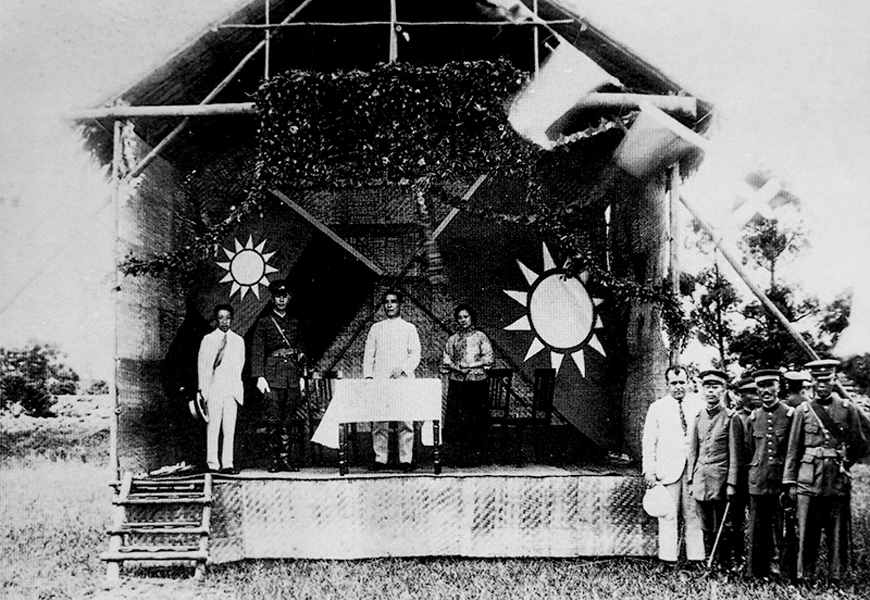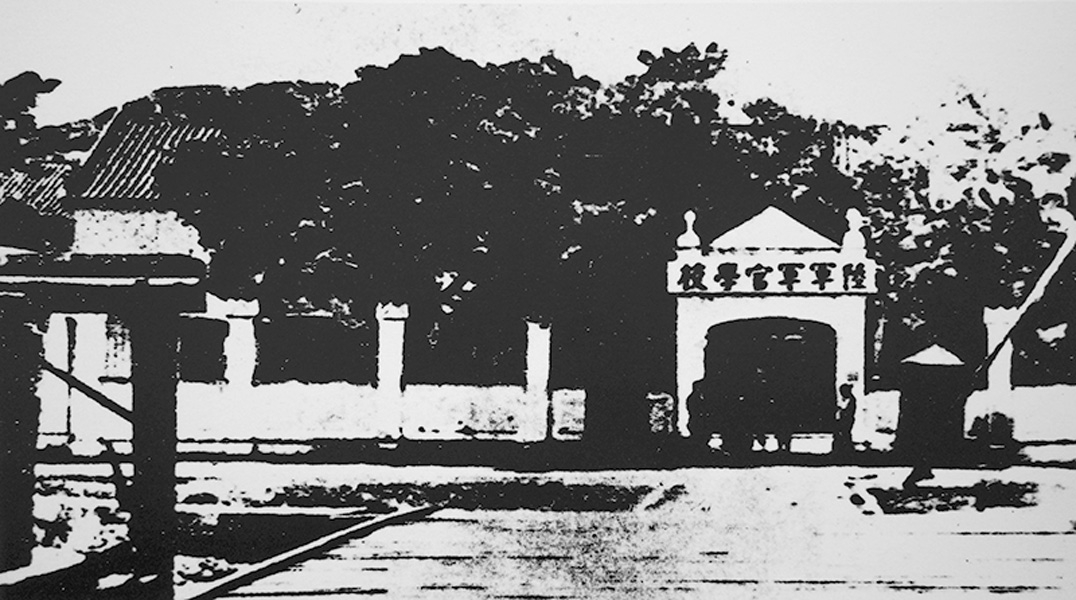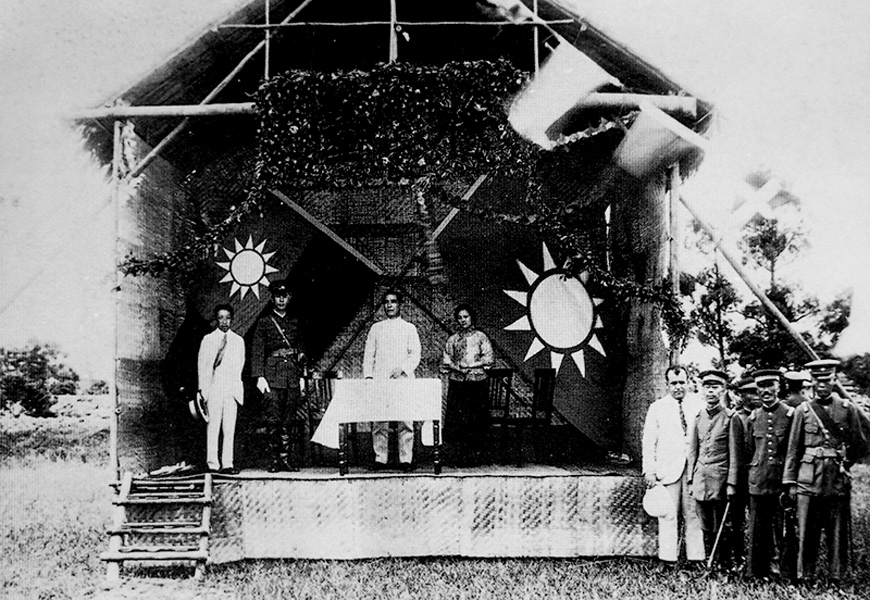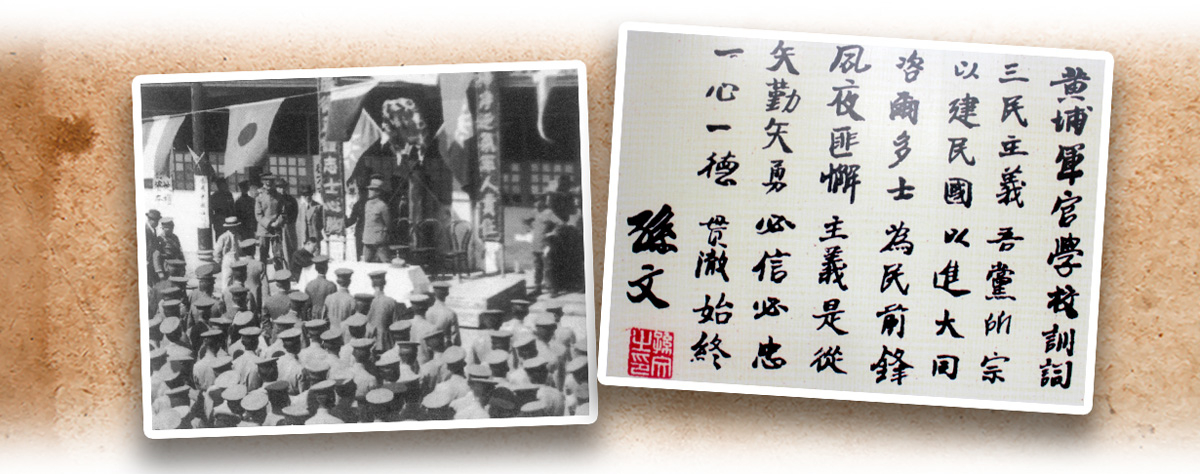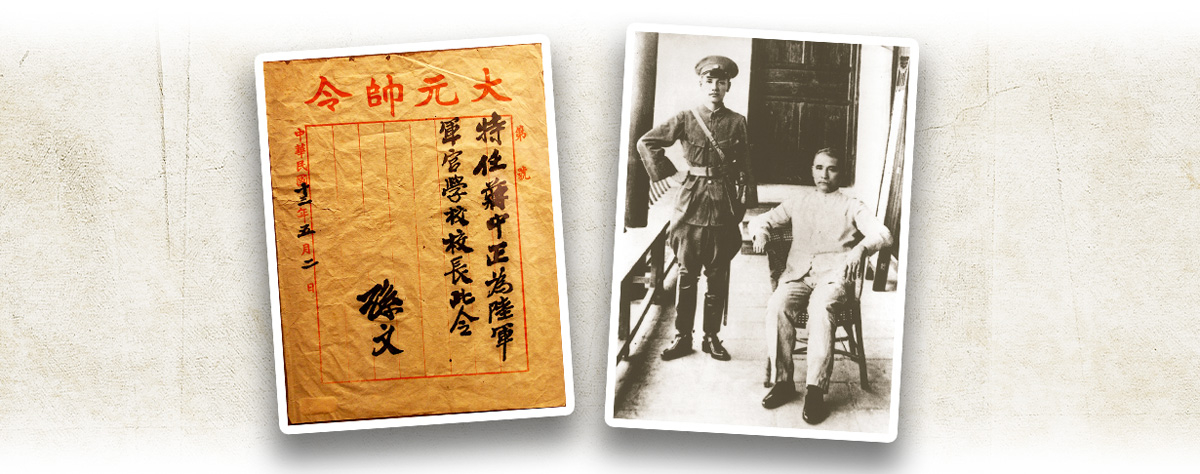The Whampoa (Huangpu) Military Academy (黃埔軍校) is the abbreviated name for the Military Academy of Kuomintang of China (中國國民黨陸軍軍官學校, renamed the Republic of China Military Academy﹝中華民國陸軍軍官學校﹞in 1946). It was named after its establishing site Huangpu (黃埔), Guangzhou (廣州). Having been repeatedly attacked, sidelined, and betrayed by the Beiyang (北洋) warlords, south-western warlords, and Guangdong (廣東) warlords since the Constitutional Protection War (護法戰爭), Sun Yat-sen (孫中山) became convinced to establish a revolutionary army.
When restructuring the Kuomintang of China (KMT), Sun received aid from the Soviet Union in the form of armaments, technology, military advisers, and so forth. At the First National Congress of the Kuomintang of China held in January 1924, a resolution was passed to establish a military academy. On 16 June the same year, a ceremony was held on Changzhou Island (長洲島) of Huangpu – the former site of the Guangdong Naval Academy (廣東海軍學校, which had been the Guangdong Naval and Military Academy﹝廣東水陸師﹞during the Qing dynasty﹝清朝﹞) – to mark the opening of the KMT’s own military academy.
Sun hosted the opening ceremony as Generalissimo. He appointed Chiang Kai-shek (蔣介石) and Liao Zhongkai (廖仲愷) as commandant of the Whampoa Military Academy and representative of KMT respectively. He also appointed Li Jishen (李濟深) and Deng Yanda (鄧演達) as director and vice-director of the Academy’s Department of Training; Wang Bailing (王柏齡) and Ye Jianying (葉劍英) as director and vice-director of the Department of Instruction; and Dai Jitao (戴季陶) and Zhou Enlai (周恩來) as director and vice-director of the Department of Politics (Zhou would later become the department’s acting director, then director). The Soviet advisor Mikhail Markovich Borodin assumed the post of chief advisor for a time.
The Academy went on to train many outstanding military commanders such as Hu Zongnan (胡宗南), Du Yuming (杜聿明), Huang Wei (黃維), Chen Gang (陳賡), Xu Xiangqian (徐向前), and Lin Biao (林彪). Most of them won great acclaim in the two Eastern Campaigns, the Northern Expedition, the War of Resistance against Japanese Aggression, and the Chinese Civil War.
During the opening ceremony of the Whampoa Military Academy, Sun penned a precept dedicated to the Academy. Later, the precept was adapted into the lyrics of the KMT’s party song and the national anthem of the Republic of China in 1929 and 1937 respectively.
|
|
The Whampoa Military Academy trained many military commanders for both the KMT and the Chinese Communist Party (CCP, 中國共產黨). Who are some of its notable graduates? |
|
|
See answer below. |
The main entrance to the military academy in Huangpu (or Whampoa), Guangzhou, in 1924. It came to be known as the Whampoa Military Academy for its location. After concluding his experience and lessons learned, Sun was determined to establish a military academy so that the KMT as a revolutionary party had its own army.
The Whampoa Military Academy was officially founded on 16 June 1924. Pictured is the reviewing stand set up for the opening ceremony. From left to right: Liao Zhongkai, Chiang Kai-shek, Sun Yat-sen, and Soong Ching-ling (宋慶齡).
Sun Yat-sen reviewing the troops on the drill ground of Whampoa Military Academy during the opening ceremony.
On the left: Sun Yat-sen addressing to the Whampao Military Academy’s cadets on a podium during the Academy’s opening ceremony; on the right: the precept dedicated to the Whampao Military Academy, penned by Sun himself. The precept was adapted into the lyrics of the KMT’s party song and the national anthem of the Republic of China in 1929 and 1937 respectively.
On the left: a generalissimo’s order appointing Chiang Kai-shek as commandant of the Whampoa Military Academy. It was signed by Sun Yat-sen on 2 May 1924 during the preparation of the Academy’s establishment; on the right: Sun took a photo with Chiang after the Academy’s opening ceremony.
On the left: Sun Yat-sen threw a banquet for the Soviet advisory group; on the right: General Galen, the chief Soviet advisor for the Whampao Military Academy. The Soviet Union was a staunch supporter of Sun back then, and dispatched an advisory group to participate in the founding and teaching of the Academy.
From the left: The Outline of Political Speeches (《政治講演大綱》), a political textbook compiled by the CCP member Yun Daiying (惲代英) for the Whampoa Military Academy; Dai Jitao (centred) and Zhou Enlai (right). Some of the Whampoa Military Academy’s practices – delivering lectures on political theory and propagating revolutionary ideas to cadets, for example – were modelled on the practices of the Soviet Union’s Red Army. The political education was in charge by the Academy’s Department of Politics. In the Academy’s founding days, the KMT member Dai and the CCP member Zhou served as the Department of Politics’ director and vice-director respectively.
The Whampoa Military Academy cadets at an artillery drill.
Besides military training, the Whampoa Military Academy cadets were educated in various other disciplines.
On the left: The Whampoa Military Academy cadets during the opening ceremony on 16 June 1924. On the right: a graduation certificate issued to Pan Xueyin (潘學吟), one of the Academy’s first cohort of cadets. The Academy cultivated outstanding military talents, many of whom would play a pivotal role in China’s military and political circles.
|
|
The Whampoa Military Academy trained many military commanders for both the KMT and the CCP. Who are some of its notable graduates? |
|
|
The Whampoa Military Academy was an incubator of military talent. Prominent KMT commanders included Du Yuming, Hu Zongnan (胡宗南), Guan Linzheng (關麟徵), Huang Wei (黃維), Zheng Dongguo (鄭洞國), Song Xilian (宋希濂), Sun Yuanliang (孫元良), Li Xianzhou (李仙洲), Zhang Lingfu (張靈甫), Li Mo’an (李默庵), Chen Mingren (陳明仁), Zheng Jiemin (鄭介民), Li Yannian (李延年), Li Mi (李彌), Hau Pei-tsun (or Hao Baicun, 郝柏村), Fan Hanjie (范漢傑) and Qiu Qingquan (邱清泉). Prominent CCP commanders who hailed from the Whampao Military Academy included Zuo Quan (左權), Chen Geng, Xu Xiangqian, Lin Biao, Liu Zhidan (劉志丹), Luo Ruiqing (羅瑞卿), Zhou Shidi (周士第), Xu Guangda (許光達), Chen Bojun (陳伯鈞), Song Shilun (宋時輪), and Tao Zhu (陶鑄). |
Sources of most photos used in this feature piece: Fotoe and misc. photo sources.




